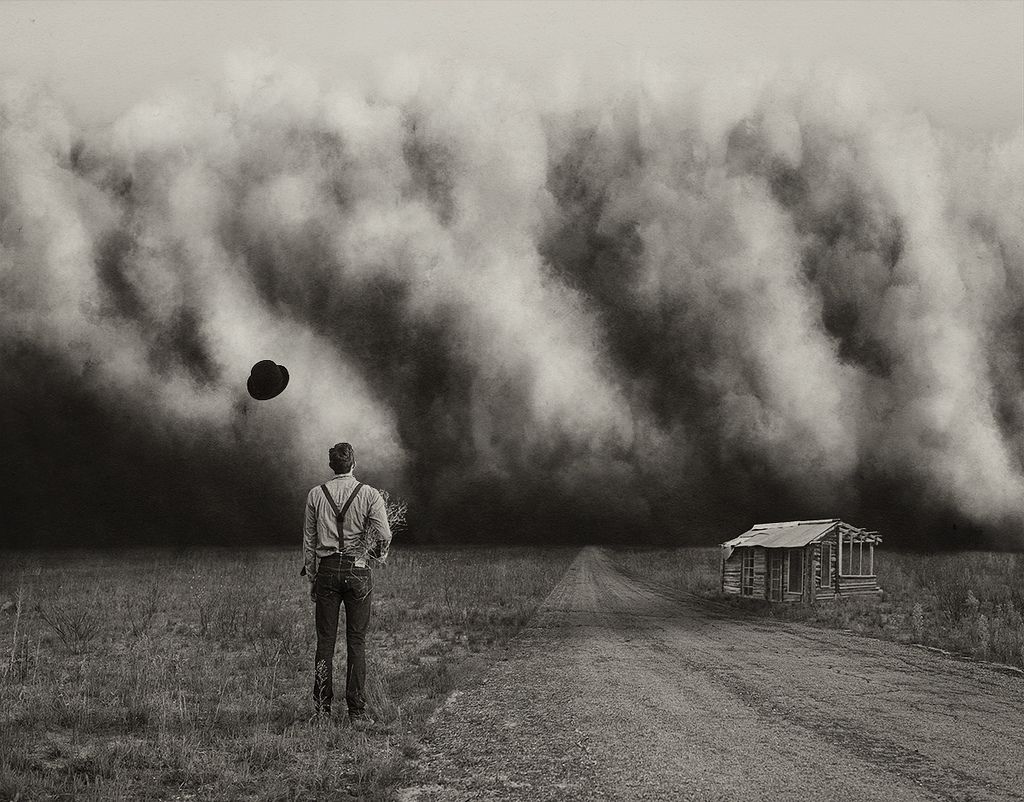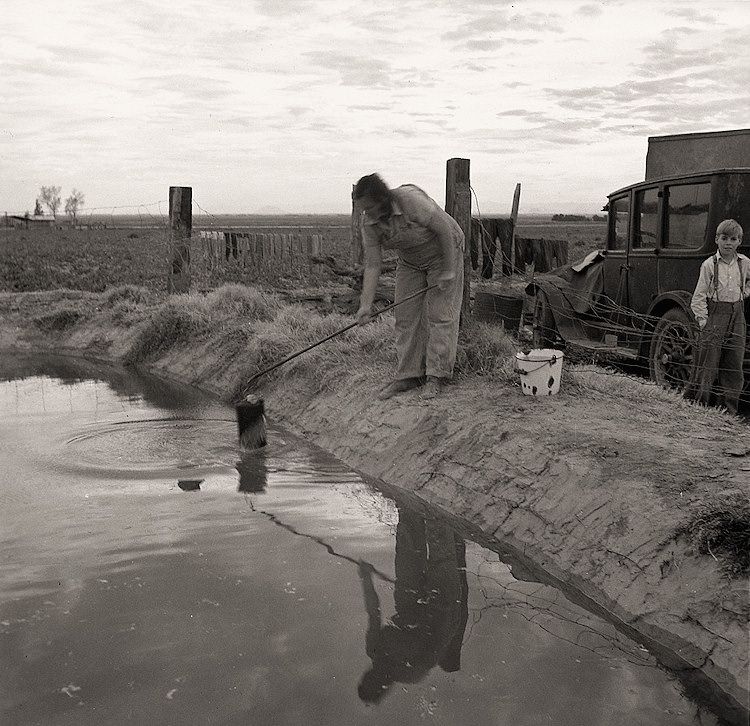With insufficient understanding of the ecology of the plains. It covered tens of millions of acres of land and affected states such as oklahoma, texas, colorado, kansas, and new mexico.
 Oakies driving to California during the Great Depression
Oakies driving to California during the Great Depression
The dust bowl was a period of severe dust storms that greatly damaged the ecology and agriculture of the american and canadian prairies during the 1930s;

Dust bowl of the 1930s. It now describes the area in the united states most affected by the storms, including western kansas, eastern colorado, northeastern new mexico, and the oklahoma and texas panhandles. Dust is too much for this farmer's son in cimarron county, oklahoma. the seeds of the dust bowl may have been sowed during the early 1920s.
This event was called, the dust bowl. Many bought plows and other farming equipment, and between 1925 and 1930 more than 5 million acres of previously unfarmed land was plowed [source: During the 1930s, the united states experienced one of the most devastating droughts of the past century.
The dust bowl got its name after black sunday, april 14, 1935. Dust bowl facts — facts about the dust bowl summary “dust bowl” is a term that was originally coined by associated press journalists to refer to the geographical area of the great plains in the usa and canada which was hit by violent dust storms in the 1930s, but is nowadays used to describe the whole event. The dust bowl term is used to describe the massive dust storms that formed in the plains during the 1930s.
The huge dust storms that ravaged the area destroyed crops and made living there untenable. But the dust bowl drought was not meteorologically extreme by the standards. In 1932, 14 dust storms were recorded on the plains.
Throughout most of the 1930s and into the early 1940s, the dust bowl turned much of what's now known as the american heartland into a virtual wasteland. Imagine soil so dry that plants disappear and dirt blows past your door like sand. And if any group should summon such a stare, it's those who lived through the dust bowl, the worst manmade ecological disaster in american history.
In 1933, there were 38 storms. For almost seventy years the story of white families from oklahoma and neighboring states making their way to california in the midst of the great depression has been kept alive. The dust bowl of the 1930s sent more than a million residents of the area to california.
Csa].with the help of mechanized farming, farmers produced. An example of a time this happened was during the early 1930s. The dust bowl results of a dust storm, oklahoma, 1936.
Three million people left their farms on the great plains during the drought and half a million migrated to other states, almost all to the west. Dust bowl, section of the great plains of the united states where overcultivation and drought during the early 1930s resulted in the depletion of topsoil, which was carried off in windblown dust storms that forced thousands of families to leave the region at the height of the great depression. Previous section art and entertainment in the 1930s and 1940s;
The dust bowl was the name given to an area of the great plains (southwestern kansas, oklahoma panhandle, texas panhandle, northeastern new mexico, and southeastern colorado) that was devastated by nearly a decade of drought and soil erosion during the 1930s. It was the worst drought in north america in 1,000 years. The dust bowl was a natural disaster that devastated the midwest in the 1930s.
The dust bowl drought of the 1930s was one of the worst environmental disasters of the twentieth century anywhere in the world. The term dust bowl initially described a series of dust storms that hit the prairies of canada and the united states during the 1930s. According to credible sources, the dust bowl was a catastrophic event in american history that led many people into economic turmoil.
The dust bowl drought of the 1930s was one of the worst environmental disasters of the twentieth century anywhere in the world. At the same time, the climatic effects all but dried up an already depressed american economy in the 1930's creating millions of dollars in damages. As high winds and choking.
(library of congress) the dust bowl and drought devastated some farm families in the early 1930's, such as this 32 year old mother of seven. Gilmore car museum circa 1935: Three million people left their farms on the great plains during the drought and half a million migrated to other states, almost all to the west.
In this study, we present model results that indicate that the drought was caused by anomalous tropical sea surface. The dust bowl was a period when severe drought and dust storms struck parts of the american great plains. The dust bowl migration of the 1930s plays an important and complicated role in the way americans talk about the history of poverty and public policy in their country.
The dust bowl was a sizeable drought that destroyed the agriculture of the midwest united states. The effects of the dust bowl drought devastated the united states central states region known as the great plains (or high plains). The loss of arable farmland during the dust bowl led to a mass migration of many families who searched for work and a new lease on life in states like california.
Next section president franklin delano roosevelt and the new deal; Learn more about this period and its impacts. Deflation affected the dust bowl in the 1930s by lowering the prices for food and other farm commodities, making it even more difficult for farmers to.
The dust bowl of the 1930s kaushik patowary sep 26, 2017 1 comments the 1930s were some of the driest years in american history. Though the depression still looms larger in the american mind, the dust bowl was no less. Pinterest car buried by a dust storm.
Of all the droughts that have occurred in the united states, the drought events of the 1930s are widely considered to be the “drought of record” for the nation. That’s what really happened during the dust bowl. Unsustainable farming practices worsened the drought’s effect, killing the crops that kept the soil in place.
Because it spanned the 1930s, the dust bowl is sometimes called the “dirty thirties.” Severe drought and a failure to apply dryland farming methods to prevent the aeolian processes caused the phenomenon. By 1934, it was estimated that 100 million acres of farmland had lost all or most of the topsoil to the winds.
The black blizzards started in the eastern states in 1930, affecting. Three girls modeling various dustbowl masks to be worn in areas where the amount of dust in the air causes breathing difficulties. Dust bowl conditions in the 1930s wrought devastation across the us agricultural heartlands of the great plains, which run through the middle of the continental us stretching from montana to texas.
Unlike the dust storms that form in arizona or new mexico that last only a few hours. The dust bowl the dust bowl describes the huge dust storms that occurred in the 1930s which created serious agricultural and economic problems in the southern great plains and parts of the midwest and the south. Eight long years of drought, preceded by inappropriate cultivation technique, and the financial crises of the great depression forced many farmers off the land abandoning their fields throughout the great plains that.
More and more dust storms had been blowing up in the years leading up to that day.
 Dorothea Lange. Migrant pea pickers camp in the rain
Dorothea Lange. Migrant pea pickers camp in the rain
 LIFE Dust Bowl survivors Denim jackets, Dr. who and Prison
LIFE Dust Bowl survivors Denim jackets, Dr. who and Prison
 Dust Bowl 1935. “These farm implements should never have
Dust Bowl 1935. “These farm implements should never have
 Memories of the 1930s dust bowl. Dust bowl, History, 1930s
Memories of the 1930s dust bowl. Dust bowl, History, 1930s
 The Dust Bowl Black Sunday Dust bowl, No mans land, Dust
The Dust Bowl Black Sunday Dust bowl, No mans land, Dust
 sharecropper families of the 1930s Walker evans, Ben
sharecropper families of the 1930s Walker evans, Ben
 Pin by scott W on The Dust Bowl & Great Depression Pinterest
Pin by scott W on The Dust Bowl & Great Depression Pinterest
 Camp for migrant agricultural and seasonal cannery workers
Camp for migrant agricultural and seasonal cannery workers
 THE DUST BOWLWorst manmade ecological disaster in
THE DUST BOWLWorst manmade ecological disaster in
 Photos of Dust bowl, Old photos, Dust storm
Photos of Dust bowl, Old photos, Dust storm
 The Dust Bowl Life Styles IV..The 1930's…Great
The Dust Bowl Life Styles IV..The 1930's…Great
 20 Tragic Photos from America's Dust Bowl in the 1930s
20 Tragic Photos from America's Dust Bowl in the 1930s
 The History Place Dorothea Lange Photo Gallery
The History Place Dorothea Lange Photo Gallery
 1930s mississippi Mississippi, 1930's Appalachia
1930s mississippi Mississippi, 1930's Appalachia
 Abandoned Dust Bowl era farm homestead in Texas County
Abandoned Dust Bowl era farm homestead in Texas County



